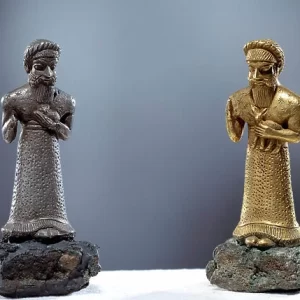The world of archaeology never fails to astound us with its ability to unearth the mysteries of the past. In one such extraordinary discovery, a 3,300-year-old hairstyle on a preserved ancient Egyptian head has emerged as a fascinating window into the beauty and grooming practices of an ancient civilization. This astonishing find sheds light on the sophistication and artistry that thrived in ancient Egypt and offers a glimpse into the lives of those who lived millennia ago.

The remarkable discovery was made during an excavation in the ancient city of Amarna, located in modern-day Egypt. Amarna served as the capital city established by the Pharaoh Akhenaten during the 18th Dynasty of ancient Egypt. The site is renowned for its historical significance and for providing unique insights into the artistic and cultural developments of the period.

Archaeologists stumbled upon the well-preserved head, believed to be that of a noblewoman or a member of the royal family, in a tomb within the city’s elite cemetery. The head was carefully wrapped in linen, a common practice in ancient Egyptian burial rituals, which contributed to its remarkable preservation.
The most striking feature of the ancient head is its elaborate and finely crafted hairstyle. Adorned with intricate braids, waves, and plaits, the hairstyle showcases the meticulous grooming and attention to detail that ancient Egyptians held in high regard. The hair is fashioned in a way that reflects the beauty ideals of the time, indicating that hairstyles were not merely a matter of personal preference but deeply intertwined with cultural and societal norms.

Hairstyles in ancient Egypt were not only a symbol of beauty but also served as markers of social status and identity. The hairstyle found on the preserved head might provide valuable clues about the individual’s role in society and her connection to the royal court, making it an essential piece in the puzzle of understanding ancient Egyptian social hierarchies.
The artistry displayed in the ancient hairstyle is a testament to the exceptional skill of ancient Egyptian craftsmen and hairdressers. Creating such intricate and well-preserved hairstyles with limited tools and resources is a remarkable feat, showcasing the advanced artistic abilities that were present in the civilization.

Furthermore, the symbolism embedded in hairstyles held significant importance in ancient Egyptian culture. Certain hairstyles were associated with specific deities or religious practices, making them an essential aspect of religious life. Additionally, hairstyles were often linked to specific life events, such as rites of passage or marriage ceremonies, making them integral to the cultural fabric of ancient Egyptian society.

The discovery of the 3,300-year-old hairstyle in the ancient Egyptian head remains one of the immense values of preserving our historic heritage. Through meticulous excavation, conservation, and study, archaeologists have been able to unravel the secrets of the past and piece together the fascinating narratives of ancient civilizations.
In museums and research institutions, such discoveries serve as a bridge connecting our contemporary world with the wisdom, creativity, and ingenuity of those who lived through these epochs of years before us. They inspire us to appreciate the cultural diversity and achievements of our ancestors and to recognize the significance of heritage preservation for future generations.

The 3,300-year-old hairstyle in the preserved ancient Egyptian head is more than just a relic from the past; it is a glimpse into a world that existed long before our time. The intricate craftsmanship, cultural symbolism, and historical context of the hairstyle provide invaluable insights into the lives of ancient Egyptians. As we marvel at this astonishing discovery, we are reminded of the unbreakable bond that connects us with our ancestors and the importance of cherishing and safeguarding our shared heritage for generations to come.





